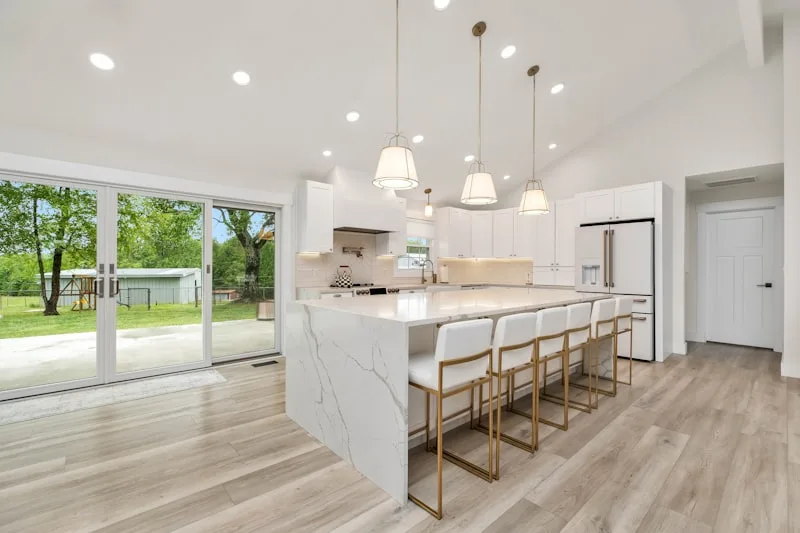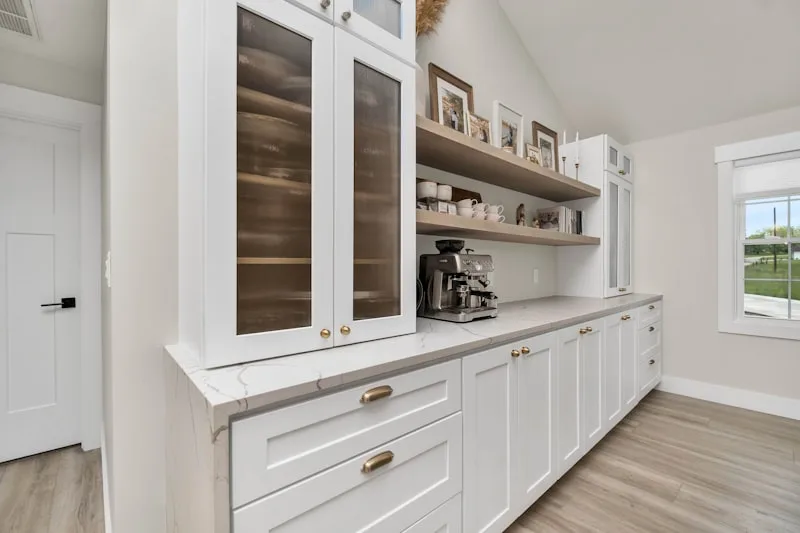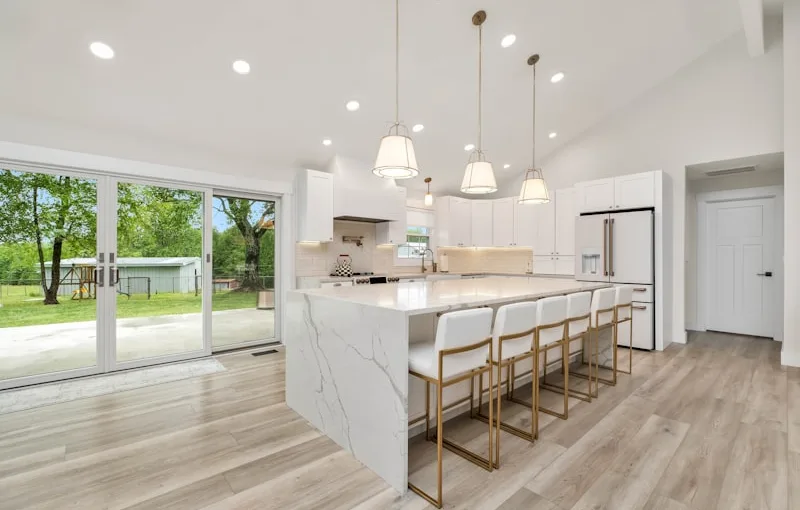First off, the quality of the paint plays a huge role. If you skimped on the paint, you might be paying the price now. Cheap paints often lack the durability needed for high-traffic areas like kitchens. Think of it like using a flimsy umbrella in a storm; it’s just not going to hold up!
Next, consider the prep work. Did you or your contractor properly sand and prime the cabinets before painting? If not, the paint might not have adhered well, leading to that unsightly chipping. It’s like trying to stick a Post-it note on a greasy surface—it just won’t stick!
Humidity and temperature fluctuations can also wreak havoc on your cabinets. Kitchens can get steamy, especially when you’re whipping up a storm. If the paint wasn’t designed to withstand moisture, it could start peeling faster than you can say “dinner’s ready!”

Lastly, let’s not forget about the application technique. If the paint was applied too thickly or unevenly, it’s bound to crack and chip. Imagine trying to walk on a frozen lake; if the surface isn’t solid, you’re going to fall through!
So, if you’re staring at those chipped cabinets, take a moment to reflect on these factors. It might just save you from a kitchen makeover disaster!
Unveiling the Mystery: Why Are Your New Kitchen Cabinets Losing Their Luster?
First off, let’s talk about the environment. Kitchens are bustling hubs of activity, filled with cooking, cleaning, and sometimes even chaos. The steam from boiling pots, the splatters from frying pans, and the occasional spill can all contribute to that dull finish. Think of it like a workout for your cabinets—they’re working hard, and sometimes they just need a little TLC to keep shining.

Then there’s the quality of the materials. Not all cabinets are created equal. If you’ve opted for lower-quality finishes, they might not stand up to the daily grind. It’s like choosing a cheap pair of shoes; they might look good at first, but they won’t last through the marathon of life. Investing in high-quality finishes can make a world of difference in maintaining that fresh look.
And let’s not forget about cleaning habits. Are you using the right products? Harsh chemicals can strip away the protective layers, leaving your cabinets looking tired and worn. It’s like using sandpaper on your skin—definitely not a good idea! Instead, opt for gentle cleaners that will treat your cabinets with the care they deserve.
So, if your new kitchen cabinets are losing their luster, take a moment to consider these factors. With a little attention and the right approach, you can bring back that radiant glow and keep your kitchen looking fabulous for years to come.
From Fresh to Flaky: The Surprising Reasons Behind Chipping Paint on Kitchen Cabinets
First off, let’s talk about moisture. Kitchens are notorious for humidity, especially when you’re whipping up a storm with boiling pots and sizzling pans. This moisture can seep into the wood, causing it to swell and contract. Imagine a sponge soaking up water—eventually, it can’t hold any more, and it starts to break down. That’s what happens to your cabinets! The paint can’t keep up with the wood’s dance, leading to those unsightly chips.
Then there’s the quality of the paint itself. Not all paints are created equal. If you went for the cheapest option, you might be setting yourself up for disappointment. Low-quality paint can peel and chip like a bad sunburn. Think of it like wearing a flimsy raincoat in a downpour; it’s just not going to hold up. Investing in high-quality, kitchen-specific paint can save you from future headaches.
And let’s not forget about the application process. Did you know that improper prep work can lead to paint failure? If the surface wasn’t cleaned or primed correctly, it’s like trying to build a house on sand. The paint needs a solid foundation to stick to, or it’ll just flake off at the first sign of trouble.
Is Your Kitchen Cabinet Paint Peeling? Here’s What You Need to Know!
First off, let’s talk about why this happens. Kitchen cabinets are constantly exposed to heat, moisture, and the occasional splatter from your culinary adventures. Over time, this can cause the paint to lose its grip, much like a tired athlete who’s run one lap too many. If you notice peeling, it’s often a sign that the paint wasn’t properly applied or that the surface wasn’t prepped correctly. Think of it as a house that needs a solid foundation before you can build the walls.
Now, what can you do about it? Start by assessing the damage. If it’s just a small area, you might be able to touch it up with some matching paint. But if the peeling is widespread, it might be time for a more extensive makeover. Sanding down the affected areas and applying a fresh coat can work wonders. It’s like giving your cabinets a refreshing spa day!
The Hidden Culprits: Factors That Cause Paint to Chip on New Kitchen Cabinets
First off, let’s talk about the quality of the paint itself. Not all paints are created equal! If you skimped on the paint, you might be setting yourself up for failure. Cheap paint can lack the durability needed to withstand the hustle and bustle of a kitchen. Think of it like trying to run a marathon in flip-flops—it’s just not going to hold up!
Next, consider the surface preparation. Did you or your contractor properly sand and prime the cabinets before painting? If not, it’s like trying to stick a band-aid on a wet surface; it just won’t adhere properly. Proper prep is crucial for a smooth, long-lasting finish.
Humidity and temperature fluctuations are also sneaky factors. Kitchens can get steamy, especially when you’re whipping up a storm. High humidity can cause paint to bubble and peel, while drastic temperature changes can lead to expansion and contraction, making chips more likely. It’s like putting a cold drink in a hot car—things are bound to get messy!
New Cabinets, Old Problems: Understanding Paint Adhesion Issues in Your Kitchen
First off, think of paint like a relationship. It needs a solid foundation to thrive. If your cabinets weren’t properly cleaned or prepped before painting, it’s like trying to build a house on sand. Grease, dust, and old paint can create a barrier that prevents the new paint from sticking. Imagine trying to glue two pieces of paper together with a layer of butter in between—yikes!
Temperature and humidity also play a significant role. If you painted your cabinets in a humid environment, the moisture can interfere with the paint’s ability to bond. It’s like trying to hold onto a wet bar of soap—slippery and frustrating! Ideally, you want to paint in a controlled environment where the temperature is just right, and the air isn’t too damp.
And let’s not forget about the type of paint you’re using. Not all paints are created equal! If you went for a low-quality option, you might be setting yourself up for failure. High-quality paints are designed to adhere better and withstand the daily wear and tear of a bustling kitchen. Think of it as choosing between a sturdy pair of shoes and flimsy flip-flops for a long hike—one will get you through, while the other will leave you stranded.
So, before you throw in the towel and consider a complete cabinet overhaul, take a moment to assess these factors. Understanding paint adhesion issues can save you time, money, and a whole lot of frustration!
Chipping Paint: A Kitchen Cabinet Nightmare—What Went Wrong?
First off, it’s essential to understand that not all paint is created equal. If you opted for a low-quality paint, you might as well be inviting trouble into your home. Cheap paints often lack the durability needed for high-traffic areas like kitchens, where heat, moisture, and grease are constant companions. Imagine trying to run a marathon in flip-flops—yeah, that’s your paint trying to survive in a kitchen!
Another culprit could be improper preparation. Did you clean and sand your cabinets before painting? If not, you might as well have painted on a layer of dust and grime. Think of it like trying to bake a cake without greasing the pan; it’s just not going to stick. Proper prep is crucial for ensuring that the paint adheres well and lasts longer.
Temperature and humidity also play a significant role. If you painted your cabinets during a humid summer day, the moisture in the air could have interfered with the paint’s ability to cure properly. It’s like trying to dry your hair in a rainstorm—good luck with that!
Frequently Asked Questions
Is Chipping Paint a Sign of Poor Quality Cabinets?
Chipping paint on cabinets can indicate poor quality materials or construction, but it may also result from environmental factors, improper installation, or wear and tear. Assessing the underlying cause is essential to determine if it reflects the overall quality of the cabinets.
What Causes Paint to Chip on New Kitchen Cabinets?
Chipping paint on new kitchen cabinets can occur due to several factors, including poor surface preparation, inadequate primer application, low-quality paint, or exposure to moisture and heat. Additionally, improper installation or handling can lead to stress on the paint surface, causing it to crack and peel. Ensuring proper preparation, using high-quality materials, and maintaining a stable environment can help prevent this issue.
What Should I Do If My Kitchen Cabinet Paint is Chipping?
If your kitchen cabinet paint is chipping, start by cleaning the affected area to remove grease and dirt. Lightly sand the chipped spots to create a smooth surface, then apply a primer if necessary. Once dry, repaint the area with a matching color, ensuring even coverage. For long-term prevention, consider using a high-quality paint and maintaining a consistent humidity level in your kitchen.
Can I Repaint My Cabinets to Fix Chipping Issues?
Repainting cabinets can effectively address chipping issues. Start by cleaning the surfaces, sanding down the damaged areas, and applying a primer if necessary. Choose a high-quality paint designed for cabinetry to ensure durability and a smooth finish. Proper preparation and application will help restore the appearance and extend the life of your cabinets.
How Can I Prevent Paint Chipping on My Cabinets?
To prevent paint chipping on cabinets, ensure proper surface preparation by cleaning and sanding the wood before painting. Use high-quality paint and primer designed for cabinetry, and apply multiple thin coats rather than one thick coat. Allow adequate drying time between coats and consider using a protective topcoat for added durability. Regular maintenance, such as cleaning with gentle products and avoiding harsh chemicals, will also help preserve the finish.
